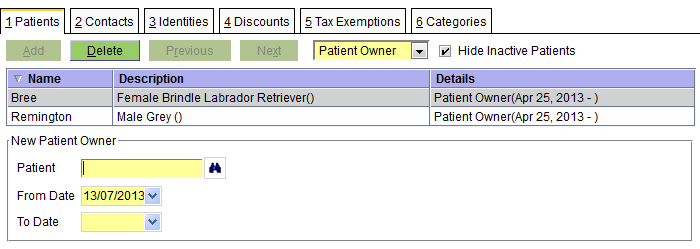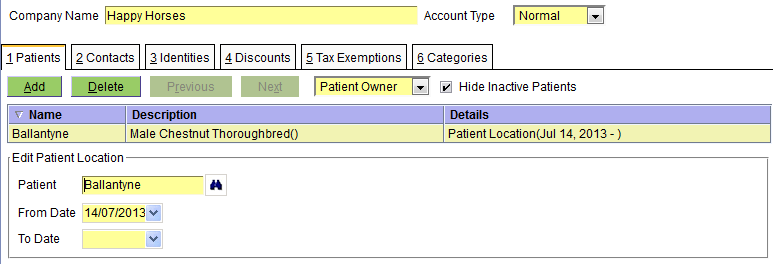Create/Edit
This is the screen used to create and edit the customer record.
Note that if you are adding a new customer & patient, the easiest way is to use the New button on the Customers|Information screen, fill in the customer details, and before pressing OK to complete the customer add, click the Add button on the Patients tab, and then click the binoculars icon following the Patient name field - this will give you the Patient Select screen on which there is a New button so that you can add the new patient for this new customer.
The fields in the header section are as follows:
Id - the customer's ID
Last Name - the customer's last name - note that you need to provide this even if the customer is a company
Title - the customer's title - select from those allowed - these are controlled by Administration|Lookups|Person Title
Initials - the customer's initials -these are best entered as 'J T' or 'J.T.' rather that 'JT' - the last will be propercased to 'Jt'.
First Name - the customer's given name(s)
Company Name - enter the company name if applicable
Referred By - if applicable, select the appropriate value from the list - these are controlled by Administration|Lookups|Customer Referral
Preferred Vet - if applicable, select the appropriate value from the list - these are controlled by Administration|Lookups|Customer Vet. Note that this is a documentation field - it does not set the default clinician for this customer.
Insurance Plan - if applicable, select the appropriate value from the list- these are controlled by Administration|Lookups|Customer Insurance. As of OpenVPMS 2.0, insurance should be managed per patient, via Patient|Medical Records|Insurance.
Travel - if applicable, enter appropriate information such as 'charge 100km for visit'
Active - untick this to deactivate the customer
Account Type - select the account type from the pull-down list. Initially the system has the following Account Types available: Normal (the default), Valued Customer, and Bad Debt. More can be added using the Administration|Lookups|Customer Account Type.
The Account Type can be used for reporting purposes (eg list all customer of type xxx), but more importantly it allows discounts to be applied (eg all valued customers get a 15% discount), and it allows customer alerts to be displayed (eg all Bad Debtor customers show with a red alert).
Practice Location - used to indicate the preferred practice of a customer, in multi-location practices. This is used as follows:
- in various reports to select a set of customers
- to select those customers for whom statements and reminders are processed
- potentially to change the content in documents as a function of the customer's preferred practice location (this requires tailoring of the varios document templates)
See also Local Procedures.
The 6 tabs Patients, Contacts, Identities, Discounts, Tax Exemptions, and Categories are documented below.
Note that in some cases, the tabs have a Hide Inactive xxxxx checkbox. This is present when the item being attached to the customer (ie the patient-owner, the patient-location, or the discount) can be deactivated (either by unsetting its Active flag, or if its To Date is in the past). In this case the item will remain attached to the customer, but the item will not be displayed and the customer will act as though the item was not attached. You can have these inactive items displayed by unchecking the Hide Inactive xxxxx box.
Patients tab
This tab is used to add/delete/edit a) 'Patient Owner' records and b) 'Patient Location' records.
Patient Owner - A patient can have multiple owners either at the same time (because the ownership is shared) or sequentially (because the patient passes from one owner to another).
The screen is as follows:

The fields are:
Patient - the name of the patient - if you use the binoculars to search you will be able (by ticking the All Patients option) to select a patient who has another owner and thus set up multiple ownership
From Date - the date from which the ownership started
To Date - the date on which it ended
Notes:
- If you do want to change the ownership of a patient, the easiest was to do it is to edit the patient record (rather than the customer record) since with the patient record, adding another owner automatically terminates the previous ownership.
- if you are simply adding patients to a customer, the easiest way to do this is to first call up the Customer|Information screen for the customer, and the click 'Patients' entry in the top menu line to switch to the Patients workspace and then simply press the New button to add the new patient to the current customer.
Patient Location - patient locations cope with the situation where the patient is owned by Dr Smith but lives at the Happy Horses stables. To cope with this, we have both Dr Smith and Happy Horses as customers. First we set up Dr Smith and his horse Ballantyne as normal. Then we set up Happy Horses as a customer, and add Ballantyne as a Patient Location record.
For the vast majority of cases, where the patients live with their owners, we don't need Patient Location Records.
The screen is as follows:

The fields are:
Patient - the name of the patient - note that the name search is done across all owners so that 'bal' will find Ballantyne
From Date - the date from which the location started
To Date - the date on which it ended
Note that given the above set up, if we go look at Ballantyne's information we see:

Note also that since a patient can only be in one place at a time, if you simply add a new Patient Location record to the patient, then the previous location will be automatically terminated.
Contacts tab
The Contacts tab (because contacts are used for customers, suppliers, etc) is documented in Concepts|Contacts.
Note that for good reminder control you should have one and only one contact (phone, email, or location) set with the purpose 'Reminder'. If you have multiple contacts with the purpose Reminder, then the first found will be used by the Reminder system. Similarly if you have no contacts set with the purpose Reminder, then the first contact found will be used for notifying reminders.
Identities tab
The Identities tab is used to set the customer's identities. Note that contrast with patients and products, customers only have one type of identity 'Code', however the customer can have multiple Code identities.

The fields are:
Code - the code - this can be anything appropriate
Description - an optional description of what the code represents (in the above case 54678 was the client number in the RxWorks system that this data was converted from)
Discounts tab
This tab is used to set the discounts that apply to the customer - see Concepts|Discounts for background.

The fields are:
Discount - the discount - note that this can either be a discount, or a discount group
From Date - the date from which the discount applies
To Date - the date on which the discount ends
Taxes Exemptions tab
This is used to exempt the customer from taxes. See Concepts|Taxes for backround information.

Use the arrows to move the selected item from the Available list to the Selected list and vice versa.
Categories tab
This is used to set the categories (zero, one, or more) to which the customer belongs. See Concepts|Categories for background information.





